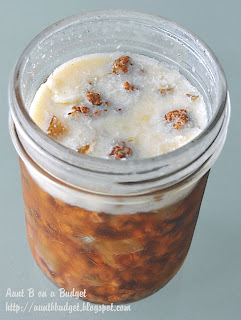Jams’n’Pans has one of my favourite pages on Facebook. She’s an inspired cook, using seasonally available ingredients in innovative ways. Her dishes are always quite beautiful, and those of her recipes that I’ve tried have proved to be delicious too.
A short while ago, Jams’n’Pans made a red currant curd flavoured with Chambourd. The curd was made in the same way a traditional lemon curd is made, but the juice and pulp of red currants was used in place of lemon juice.
I enjoy a good lemon curd and we have an abundance of blackberries right now, so Jams'n'Pans' recipe inspired me to make a curd of my own. I followed the instructions in her post and made a blackberry curd. It turned out beautifully, with deep blackberry flavour and a luxurious, smooth texture.
I used my blackberry curd to make some pretty - and pretty delicious - blackberry tarts. Here’s how I made them:
I combined 300 grams of freshly picked blackberries with 150 ml of water
and cooked them over medium heat until they came to a boil and expressed some of their juices.
I drained the berries through a sieve and then used the back of a spoon to push the berries’ pulp through the screen, leaving the seeds behind.
The sieved berries looked like this:
At that point I was ready to make the curd. I used:
- the sieved berries
- 5 medium-sized eggs
- 250 grams sugar
- 250 grams cold butter, cut into pieces
I put the sieved berries in a heat proof bowl.
I beat the eggs and added them to the sieved berries along with the sugar, stirring them until they were combined.
I added the butter to the bowl.
I heated some water to a simmer in a medium saucepan, then placed the bowl with the curd ingredients on the top of the pan, so that it rested over the simmering water without touching its surface.
I stirred, and stirred, and stirred…and stirred. It took quite a while but first the butter melted and was incorporated into the mixture, and then the mixture thickened.
It seemed to take a long time for the blackberry curd to thicken – so long, in fact, that I began to doubt that it would thicken at all - but it did thicken at last. It eventually reached the point where you could see where the spoon had been as it was drawn through the liquid. Small drops of curd drizzled back onto the surface of the liquid retained a distinct shape.
(If you are making this, resist the temptation to overcook it. The curd will continue to thicken as it cools.
If you spoon a small amount of curd into the bottom of a bowl or onto a saucer it should still be fairly liquid but, if you draw your finger through it, the liquid should not run back into the area you’ve cleared.)
Once the blackberry curd had thickened, I ladled it into two pint jars. I allowed it to cool to room temperature, then capped the jars and stored them in the fridge.
The refrigerated blackberry curd set up very well. It has a thick, spreadable consistency that would work well as a filling for cakes, a topping for cupcakes, a filling for cookies, or for individual tarts.
I’d recently been given a sleeve of small premade, frozen, unsweetened pastry shells. This was an opportunity to use them. I allowed them to thaw, docked them with a fork so they wouldn’t bubble up as they baked, and then baked them in the oven until they were cooked through and the edges were lightly browned.
When the pastry shells had cooled, I removed them from their foil pans and spooned a little blackberry curd into each one. I topped the curd with some fresh blackberries.
They were quite tasty at this point but I wanted a little something-something more, so I whipped 250 millilitres of heavy cream and sweetened it with about a teaspoon of sugar, then piped the whipped cream onto the top of the tarts.
They were very pretty. When we cut into one of the tarts with a fork, it looked like this.
The premade pastry was actually quite good: well flavoured and flaky. The smooth curd and tart blackberries were wonderful together. The whipped cream added the perfect finishing touch.
The tarts didn’t last long, but they were good to the last bite.
Cook’s notes:
- The curd might have cooked more quickly if I had turned the heat up under the pot so that the water was at a low boil but I didn’t want to risk having any of the egg scramble. If you want to cook the curd at a slightly higher heat, I’m sure it will be fine. Just run the cooked curd through a sieve when transferring it into your jars.
- The little tarts I made were about 2 inches in diameter. I made a dozen of them, using about half of one of the jars of curd. I still had enough left over to fill a cake another day.
This post is linked to Gallery of Favorites hosted by Premeditated Leftovers and The 21st Century Housewife, to The Pity Party at Thirty Handmade Days, to Foodie Fridays hosted by Rattlebridge Farm, to Foodie Friends Friday hosted by Tracy at Busy Vegetarian Mom, Robyn's View, Angie at A lil Country Sugar, Marlys at This and That, Lois at Walking on Sunshine, Lindsey at Family Food Finds, Cindy at Cindys Recipes and Writings, Keira at Luscious Delights, R Dawn at Spatulas on Parade, Ericka at Chef Picky Kid, Michelle at From Calculus to Cupcakes, Cynthia at Feeding Big, Sarah at Everything in the Kitchen Sink, Skye at A Virtual Essence, to Foodtastic Friday hosted by Not Your Ordinary Recipes, to Weekend Potluck hosted by The Country Cook, Meet Penny, The Better Baker, Sunflower Supper Club, Life As a Lofthouse, 4 Little Fergusons, to Strut Your Stuff Saturday hosted by Six Sisters' Stuff, to Think Pink Sunday hosted by Flamingo Toes, to Scrumptious Sunday hosted by Addicted to Recipes, to Must Try Monday hosted by My Favorite Finds,


























































